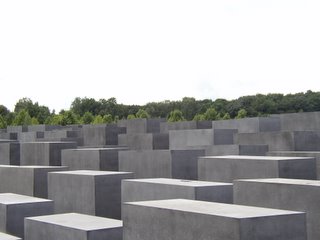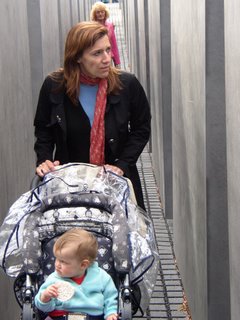If you are in St. Louis, be sure to see the Rep Theater's production of "I Am My Own Wife," about the life of the Berlin transvestite, Charlotte von Mahlsdorf. It's a wonderful play.
And, if you're in Berlin, you should check out Charlotte's
Gründerzeit Museum in suburban Mahlsdorf.
I wrote the following program notes for the St. Louis production of the play:
Berlin (Naughty and Nice) and The Passions of a Collector
Americans have this notion that everything sexy, outrageous, and exciting that ever happened in
Germany was during the
Weimar Republic. That brief period, sandwiched between the national catastrophe of World War I and the horrors of Nazism, often shows up in our movies and culture as one extravagant orgy of experimentation. Thanks to
Cabaret in particular, “
Weimar decadence” has become one of those seemingly inseparable word-pairings, like “sixties counterculture” or “1950’s Conservatism.”
The heroine of this play – a pretty sexy, outrageous, and exciting figure herself –did not care much about the
Weimar Republic. Charlotte von Mahlsdorf, born Lothar Berfelde, was a transvestite who became a popular icon in
Berlin before her death in 2002. She was born in the
Weimar Republic, grew up in the Nazi Era, and lived most of her life in Communist East Germany. Her lifelong fascination, however, was the period at the end of the nineteenth century known as the
Gründerzeit. She was an obsessive collector of
Gründerzeit bric-a-brac, lamps and vases, telephones and gramophones, and especially the era’s ornate neo-gothic and neo–renaissance furniture.
Why
Gründerzeit? Christopher Isherwood, the hip, gay, British novelist who helped invent our image of the
Weimar Republic, saw the
Gründerzeit aesthetic as the essences of dullness. This was the stuff of his elderly landlady’s apartment: Everything was
“unnecessarily solid, abnormally heavy and dangerously sharp.” Her decor, he wrote in the stories that became
Cabaret, was like “an uncompromising statement” of her views on “Capital and Society, Religion and Sex.”
Perhaps it was precisely this sense of solidity and permanence that drew
Charlotte to the
Gründerzeit. Having faced the murderous insanity of Nazism, the Anglo-American bombings, the Russian invasion, and then forty years of Communist repression, there must have been something comforting in these things which, as Isherwood wrote, looked like they could never be destroyed. Certainly there was something poignant about this quintessential outsider’s passion for the ultimate accoutrements of bourgeois family life.
But Charlotte also knew something about the
Gründerzeit that educated Americans and even most Germans never learn, which is that underneath the trappings of middle class respectability was a vibrant, teeming world of luscious perversity, experimentation, and rebellion. Indeed, almost everything we think of as distinctively “
Weimar” had its roots in the
Gründerzeit: Avante Garde art, music, and literature; gay and lesbian culture; Bauhaus architecture and experimental theater. As Peter Gay writes, the
Weimar Republic “created little; it liberated what was already there.”
At the center of this story is
Berlin. Once a provincial backwater,
Berlin in 1871 became the capital of a vast and powerful empire. A period of frenzied speculation and spectacular industrial growth transformed the city into something new. In 25 years,
Berlin’s population doubled to almost 2 million people. Developers laid new streets and built vast tenement blocks to accommodate the growth. Commuter trains, streetcars, and subways soon followed. People moved to
Berlin to work, to study, or just to take in the famous “
Berlin air” – the atmosphere of freedom, excitement, and rapid change. “The true Berliner,” a saying went, “comes from
Breslau.”
The emperor Wilhelm II tried to put his own stamp on this fast-growing city. He built pompous government office buildings, ostentatious churches, and grand boulevards and plazas for military parades. But, in a sense,
Berlin escaped him. The heart of the city – if there was one – was in the thousands of cafés and clubs where people went to read one or two of the 24 daily newspapers, argue about the topics of the day, and entertain themselves late, late, late into the night (much later than Paris, the guide books all said). In the working class districts, the dense housing and intense poverty forged a powerful sense of community and hostility toward the powers that be. Often these neighborhoods became enclaves from the repressive state and the prying eye of the censor. There were thousands of illegal prostitutes in these neighborhoods (20,000 according to some estimates), but also political cabarets, Anarchist and Marxist clubs, and experimental theaters. The Scheunen Viertel, or barn district, was only a ten minute walk from the Emperor’s Palace but at night it was effectively off-limits to the police unless they showed up in force. A number of
Berlin’s estimated 40 gay and lesbian cafes were located there, including the tavern that Charlotte von Mahlsdorf later dismantled and moved to her basement in the suburbs.
Among the many artists and intellectuals who benefited from this milieu was a young medical researcher named Magnus Hirschfeld. Hirschfeld used the gay and lesbian cafes of
Berlin for a kind of ethnographic field work. A pamphlet he wrote arguing for the legalization of homosexuality became world famous after it was used by the defense at Oscar Wilde’s trial for sodomy. Hirschfeld went on to write numerous scientific papers developing the theory that more or less all humans started out as bisexual: most lost their urge for the same sex; some remained bisexual; and others, for reasons of physiology and psychology, became homosexual. By 1900, Hirschfeld was recognized as a founder of the academic discipline of sexology and a leading pioneer of gay rights.
The guardians of respectability have periodically tried to tame
Berlin. During the
Gründerzeit, repressive legislation, police brutality, and periodic mass arrests sought to keep the underworld within boundaries. Even the most reactionary of police chiefs, however, recognized that the underworld served a broader function. Hirschfeld relished in alluding to the prominent and eminently “respectable”
Berlin industrialists and lawyers whom he ran into during his tours of gay nightlife.
After their seizure of power, the Nazis made a coordinated effort to wipe out the
Berlin underworld. Tens of thousands of “asocials” were immediately sent to concentration camps. Later, the Nazis suppressed the gay and lesbian clubs and incarcerated thousands of gay men. (Lesbians, for various reasons, were not persecuted in the same way.) Hitler, who hated
Berlin’s air of cosmopolitanism and tolerance, dreamed of razing the city and replacing it with a fascist utopia of gigantic buildings, massive plazas, and wide boulevards. Only the lost war stopped his plans. During the Communist era, the East German government continued to persecute “asocials” and homosexuals, though in more subtle ways. The secret police, or Stasi, created a massive system of spies, pitting neighbors, friends, and even spouses against each other. Blackmail was a common tool against anyone who did not fit the dominant image of proper proletarian etiquette.
Somehow the
Berlin spirit endured. Over 75% of the city was bombed in World War II. The large Jewish population – which had been so much a part of the city’s uniqueness – was hunted down almost to extinction. Postwar West Berlin became a strange, artificial enclave of western capitalism and consumerism, while postwar
East Berlin became a dull, grey zone of state control and repression. And still you find here the “Berliner Luft” – the
Berlin air or atmosphere – a certain tempo and rhythm, and a distinctly cheeky, wise-cracking, one might even say “Jewish,” sense of humor.
In
Berlin today, the most characteristic form of development is known as
Zwischennutzung. Properties that are sitting empty and unused are, with the state’s blessing, taken over by a person or group with an idea for temporary, interim reuse. In this way, hipsters and freaks have turned abandoned warehouses into experimental music clubs, theaters, and art galleries. Adhoc community groups have turned forlorn empty lots into settings for skateboarding, beach volleyball, and community gardens. Young civic-minded types have turned former areas of the Berlin Wall into staging grounds for circuses and concerts, air balloon rides, and tobogganing. And then, seemingly overnight, the
Zwischennutzung is gone. An office building or apartment complex fills up the space as if the great happening had never happened.
Looking back in time, sometimes all of
Berlin’s history seems like an endless series of
Zwischennutzungen. Wonderful, vibrant, monstrous, alluring, repellent things were built as if to last forever and disappeared as if they were never there. History in this city can be found only in discrete, scattered pieces.
Charlotte von Mahlsdorf’s passion was to collect these pieces. Perhaps she felt that
Gründerzeit’s veneer of bourgeois stability was a charming masquerade, a dragshow for the ages, or maybe – as a tour guide at her museum recently told me – she simply found comfort in the aesthetic world of her childhood. Whatever the case,
Charlotte created her own marvelous oasis of history in this city of the ephemeral.
(Sources: David Clay Large, Berlin; Christopher Isherwood, Berlin Stories; Vern Bullough, Science in the Bedroom: A History of Sex Research)



